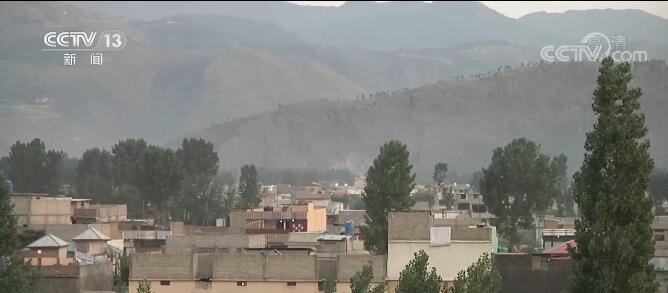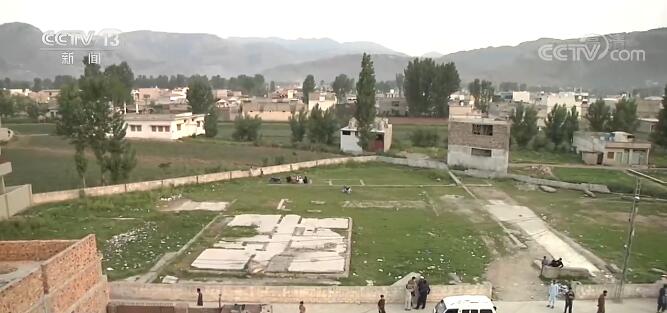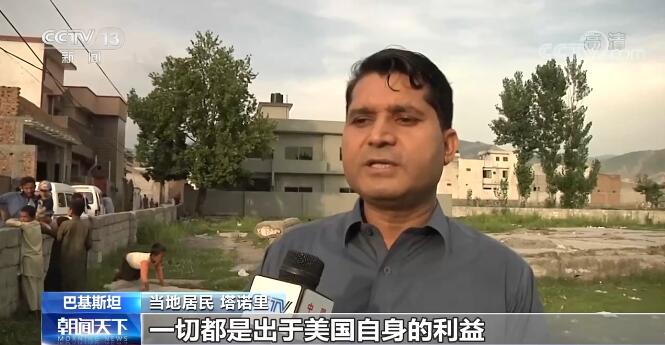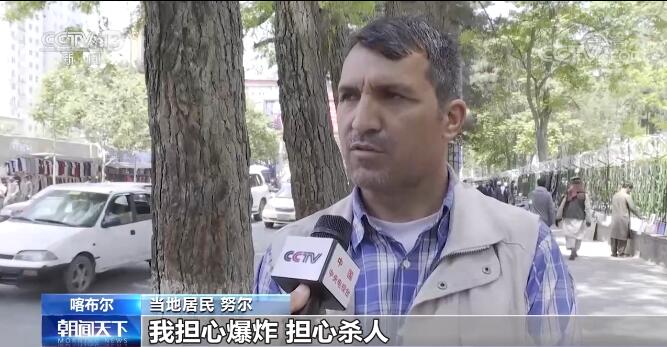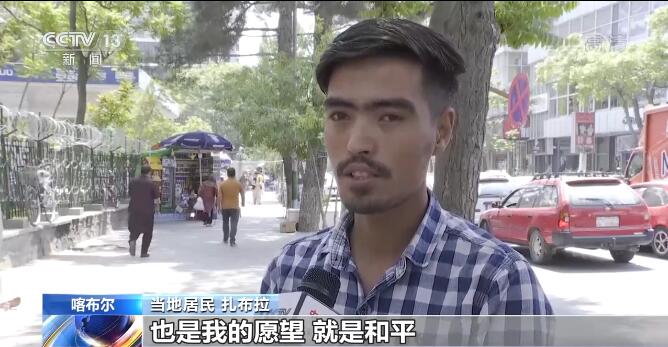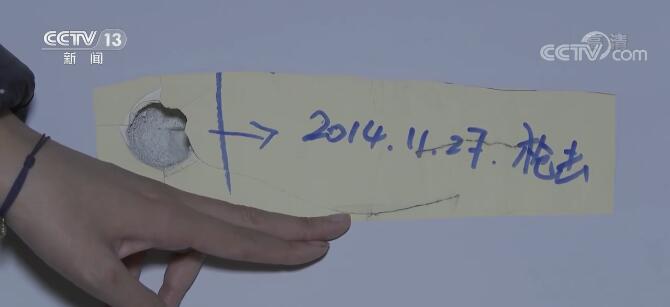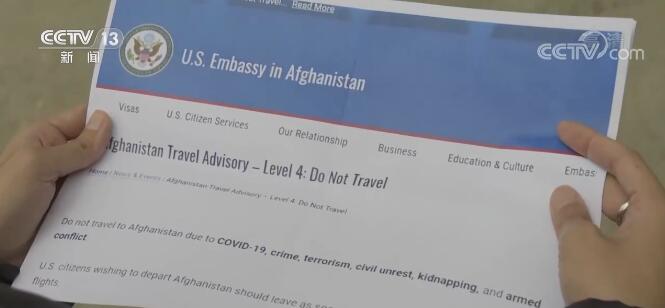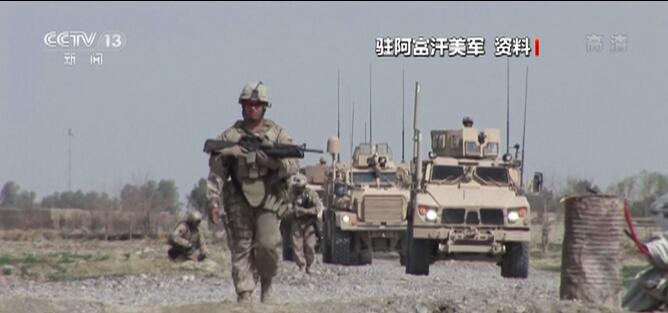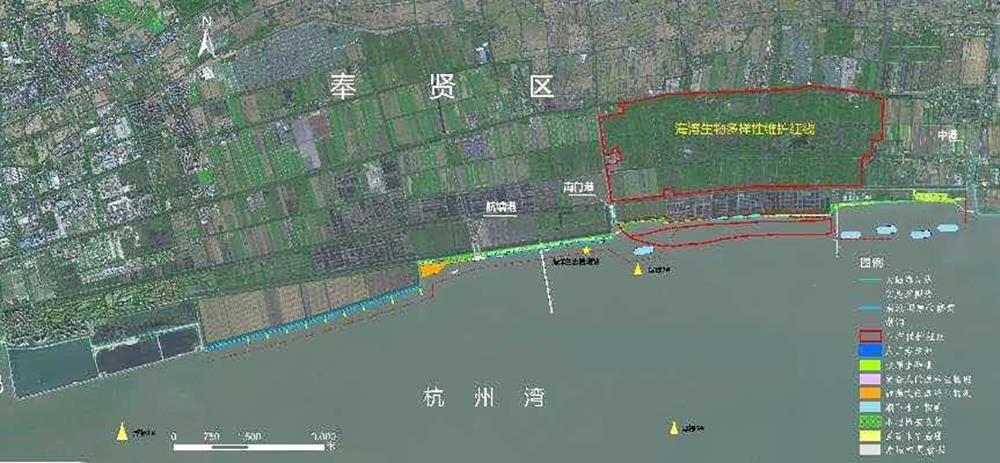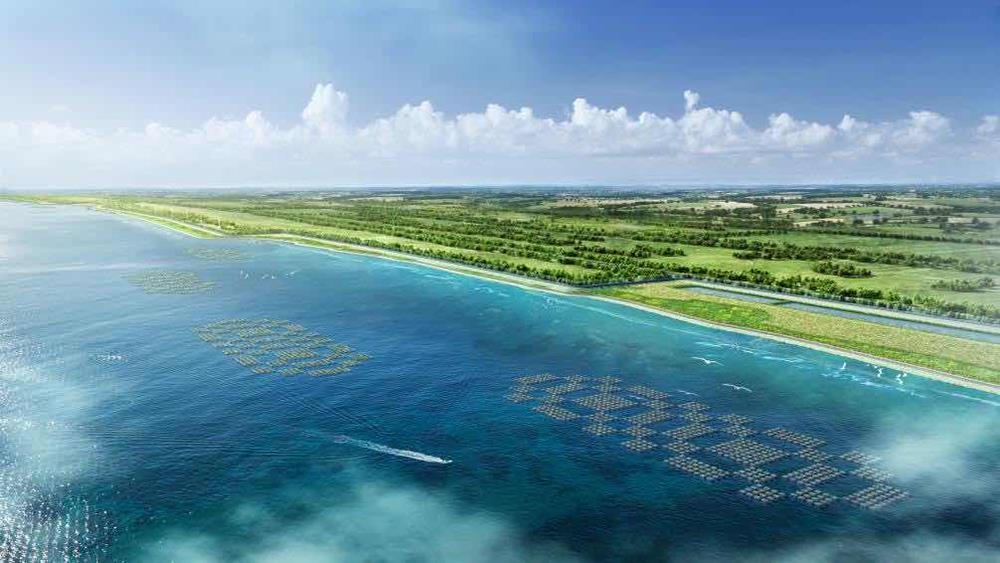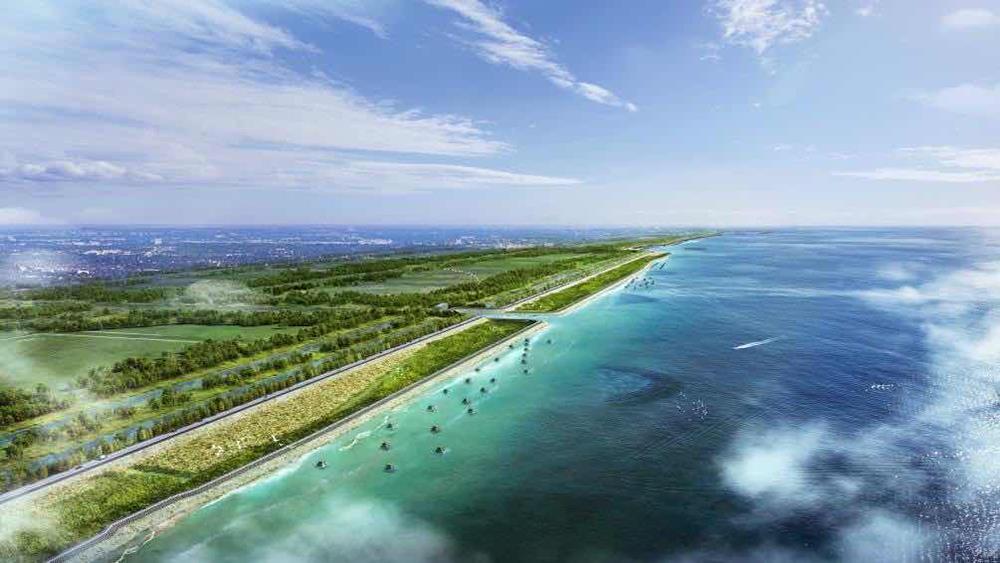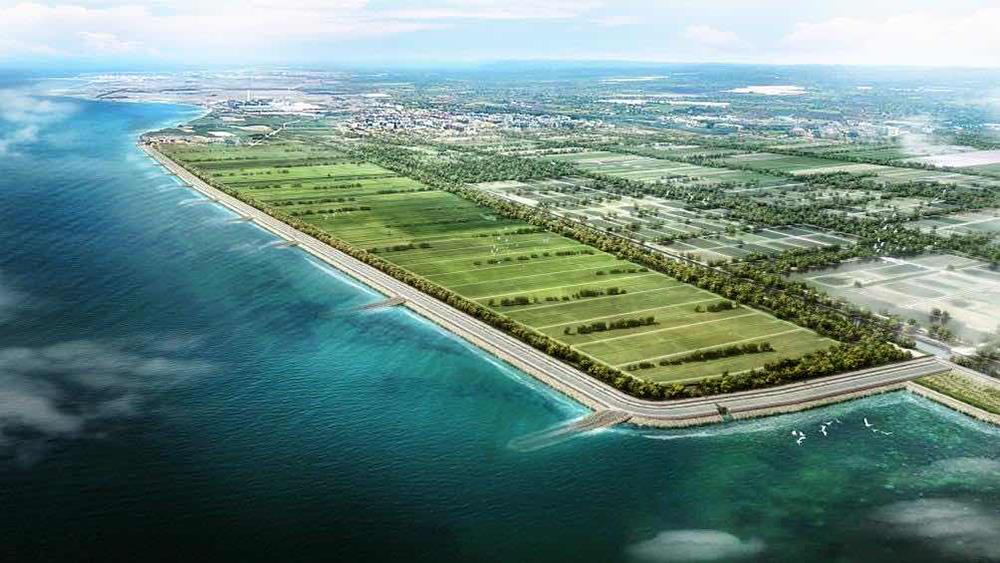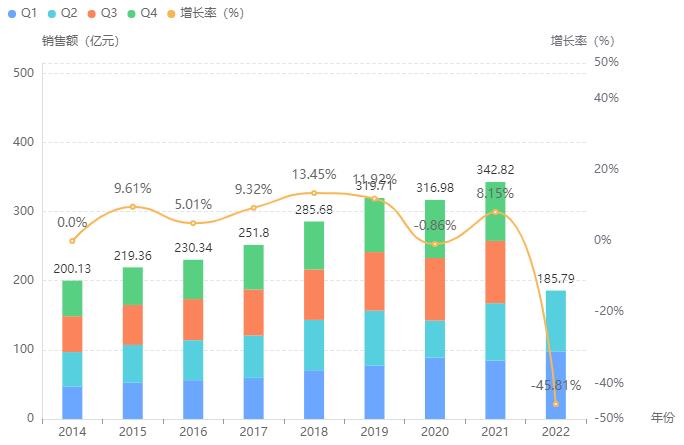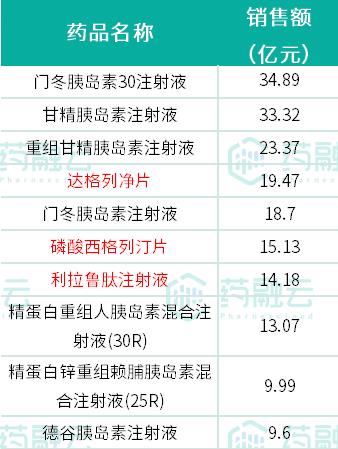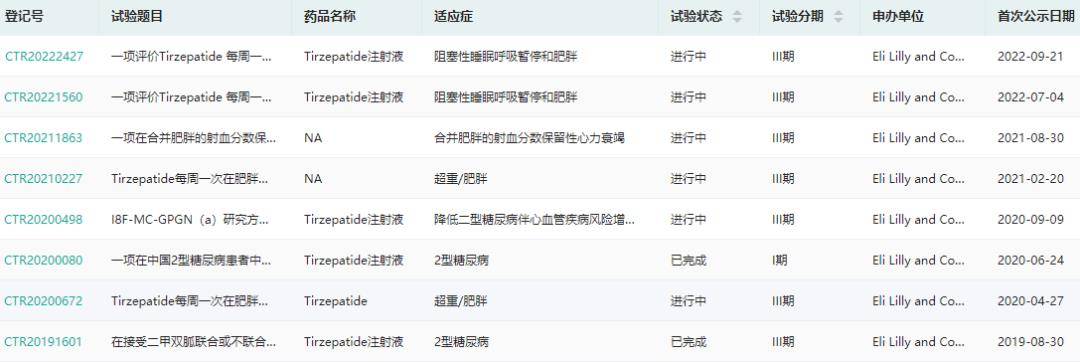Catalogue
Chapter I General Provisions
1.1 Guiding ideology
1.2 Relevant government requirements
1.3 Planning basis
1.4 Planning scope and depth
1.5 planning period
1.6 Planning object
Chapter II Demand Analysis
2.1 Mass demand for national fitness
2.2 Demand for international communication-oriented events
2.3 Emerging demand for sports consumption
Chapter III Planning System
3.1 Planning objectives and principles
3.2 Functional system
3.3 Hierarchy
3.4 Hierarchical Configuration Content
3.5 hierarchical land use standards
Chapter IV Spatial Layout
4.1 Layout principle
4.2 Spatial Circle Planning Strategy
4.3 the city’s sports land planning scheme
4.4 Different types of sports facilities layout strategy
4.5 Promote the development of urban sports industry
Chapter V Implementation Guarantee
5.1 Implementation strategy
5.2 Policy mechanism
5.3 Management and operation
Chapter I General Provisions
1.1 Guiding ideology
Guided by the Supreme Leader’s Socialism with Chinese characteristics Thought in the New Era, we will fully implement the spirit of the 19th National Congress of the Communist Party of China, thoroughly implement the national fitness strategy, promote the construction of a sports power, strictly implement the requirements of the Beijing Urban Master Plan (2016-2035) (hereinafter referred to as the Master Plan), dock the zoning plans, and implement the master plan indicators. Firmly establish a new development concept, adhere to the people-centered, around the "seven haves" and "five natures", incorporate the construction of public sports facilities into the national spatial planning, and promote the balanced development of public sports facilities. Efforts will be made to solve the problem of insufficient supply of public sports facilities, to build a functional system of public sports facilities, and to improve the benign operation mechanism of public sports facilities. We will fully promote the opening of sports facilities to the society, encourage the integrated development of various public facilities and sports facilities, further stimulate the vitality of sports, promote the development of sports industry, effectively improve the physical fitness of the people, and help the development of healthy China.
1.2 Relevant government requirements
1.2.1 spirit of relevant documents of the CPC Central Committee and the State Council.
1. National fitness is a national strategy for the development of the new era.
On August 25th, 2016, General Secretary of the Supreme Leader met with all members of the China sports delegation of the 31st Olympic Games, and expressed the hope that comrades would fully understand the positive significance of sports in improving people’s health level, implement the national strategy of national fitness, popularize national fitness exercises and promote the construction of healthy China.
On October 18, 2017, General Secretary of the Supreme Leader made a report on "Decisively Building a Well-off Society in an All-round Way and Winning the Great Victory of Socialism with Chinese characteristics in the New Era" at the 19th National Congress of the Communist Party of China, emphasizing extensive nationwide fitness activities and accelerating the construction of a sports power.
On August 10, 2019, the General Office of the State Council issued the Outline of Building a Powerful Country through Sports, which promoted the construction of a powerful country through sports, emphasized the important role of sports in the journey of building a modern and powerful socialist country, and strived to build sports into a symbolic cause of the great rejuvenation of the Chinese nation.
2. The Winter Olympics is an important window to show the national image.
On February 24, 2017, General Secretary of the Supreme Leader pointed out at the symposium on Beijing urban planning and construction and preparations for the Beijing Winter Olympics that the Beijing Winter Olympics is a major landmark activity at an important historical node in China, an important opportunity to show the national image, promote national development and inspire national spirit, and has a strong traction on the coordinated development of Beijing, Tianjin and Hebei.
3. The development of youth sports is an important guarantee for the training of national reserve talents.
On February 24th, 2017, when inspecting Wukesong Sports Center and Capital Gymnasium, General Secretary of the Supreme Leader pointed out that teenagers are stronger than China and sports are stronger than China.
1.2.2 overall planning requirements
The master plan puts forward that Beijing’s development goal is "to build a world-class harmonious and livable capital". In order to achieve this development goal, we should build a high-quality and balanced public service system covering urban and rural areas in the planning and construction of living space. Among them, it is clear that public sports facilities should build a perfect public service system for national fitness, and the per capita public sports land area will increase to 0.7 square meters by 2035.
1.2.3 Municipal Party Committee and Municipal Government Work Deployment
1. Make up the shortcomings of public service facilities and promote balanced regional development.
On June 15, 2018, Comrade Cai Qi, secretary of the Municipal Party Committee, pointed out at the symposium on investigating the southern region that the shortcomings of infrastructure and public services should be filled as soon as possible. It is necessary to improve the public culture, sports and old-age service system around the requirements of education for young children, education for learning, income from labor, medical care for illness, security for the old, housing and support for the weak. On September 15th of the same year, Comrade Cai Qi, secretary of the Municipal Party Committee, proposed to build more sports and cultural facilities and organize more activities with strong mass participation when he participated in the social service activities.
2. Promote the coordinated development of Beijing-Tianjin-Hebei and improve the overall development level.
On November 20th, 2017, Cai Qi, Secretary of the Municipal Party Committee, published "Promoting the Coordinated Development of Beijing, Tianjin and Hebei" in People’s Daily. The article points out that the Beijing-Zhangjia cultural and sports tourism belt should be built together, and the sports, leisure and tourism industry clusters should be built to enhance the overall development level of the region.
1.3 Planning basis
1.3.1 National planning and policy documents
1. Outline of Building a Sports Power
2. Healthy China Action (2019-2030)
3. Opinions on Taking the 2022 Beijing Winter Olympics as an Opportunity to Develop Ice and Snow Sports.
4. "Action Plan for Strengthening Efforts to Promote Public Services in Social Fields to Make Up Shortcomings, Improve Quality and Promote the Formation of a Strong Domestic Market"
5. Guiding Opinions on Accelerating the Development of Sports Competition Performance Industry
6. Planning Outline of "Healthy China 2030"
7. The 13th Five-Year Plan for Sports Development
8. National Fitness Program (2016-2020)
9. National Football Stadium and Facilities Construction Plan (2016-2020)
10 "Several Opinions of the State Council on Accelerating the Development of Sports Industry and Promoting Sports Consumption"
11. Opinions of General Office of the State Council on Promoting National Fitness and Sports Consumption to Promote the High-quality Development of Sports Industry.
1.3.2 Local planning and policy documents
1. Beijing Urban Master Plan (2016-2035)
2. Beijing Football Stadium and Facilities Construction Plan (2016-2020).
3. Beijing Sports Development Plan during the Thirteenth Five-Year Plan Period
4. Overall Plan of Beijing Football Reform and Development
5. Beijing National Fitness Implementation Plan (2016-2020)
6. Opinions on Accelerating the Development of Ice and Snow Movement (2016-2022)
7. Special Plan for Public Sports Land in Central City and New Town of Beijing (2007 -2020).
1.3.3 Technical standards
1. Standard for Planning and Design of Urban Residential Areas (GB50180-2018)
2. Requirements for Classified Configuration of National Fitness Activity Center (GB/T34281-2017)
3. Land Use Control Index of Urban Public Sports Venues.
4. Allocation Index of Residential Public Service Facilities in Beijing
5 "Sports Training Base Construction Land Index"
6. Interim Provisions on Land Quota Index of Urban Public Sports Facilities
7. Standard for Urban Land Classification and Planning and Construction Land (GB50137-2011)
8. Code for Planning of Urban Public Facilities (GB50442-2008)
9. Code for Design of Sports Buildings (JGJ31-2003)
10. Configuration Requirements for Multifunctional Public Sports Fields in Urban Communities (GB/T 34419-2017)
1.4 Planning scope and depth
1.4.1 Planning scope
The planning scope determined in this plan is the administrative area of Beijing, with a total area of 16,410 square kilometers.
1.4.2 Planning depth
According to the spatial structure of "one core, one main and one auxiliary, two axes, multiple points and one area" in the overall planning, combined with the actual development and construction of different circles, the planning depth requirements of different circles are determined.
In order to effectively link up and guide the planning and construction of sports facilities in various administrative areas, the planning and implementation of different circles are carried out with administrative areas as units on the basis of the spatial structure determined in the overall planning.
The first core includes Dongcheng District and Xicheng District, and the first core includes Chaoyang District, Haidian District, Fengtai District and Shijingshan District. One core, one master planning depth should define the boundaries of independent public sports land, and determine the location and land area of non-independent public sports land.
A pair includes Tongzhou District (including Yizhuang Tongzhou part), many points include Shunyi District, Daxing District (including Yizhuang Daxing part), Changping District and Fangshan District, and the first area includes Mentougou District, Pinggu District, Huairou District, Miyun District and Yanqing District. The planning depth of a deputy, multi-point and one district should determine the planning location (block level) and land area of each independent public sports facility.
1.5 planning period
The planning period is from 2018 to 2035. Recent 2018 to 2025; Forward from 2026 to 2035.
The term of this plan is based on the overall planning period from 2016 to 2035.
The short-term planning period is connected with the "14 th Five-Year Plan" period from 2021 to 2025, realizing the integration of multiple regulations.
1.6 Planning object
1.6.1 Sports facilities
Sports facilities are an important part of urban public service facilities, which refer to places and ancillary equipment used to carry out national fitness, sports training, competitions, teaching and other social sports activities. The research objects of this plan include sports facilities built by using public sports land (including independent or compatible land occupation) and sports facilities in other land.
1.6.2 Public sports land
Public sports land is land specially used for the construction of urban public sports facilities, including sports venues and sports training sites. The land for affiliated sports facilities in schools, government agencies, enterprises and institutions, commercial and cultural places and parks does not belong to public sports land.
1.6.3 Sports ground
Sports venues refer to venues built on all kinds of land for sports or competitions, including indoor and outdoor venues. Public stadiums, school playgrounds, gyms in shopping malls and outdoor fitness trails all belong to the category of sports venues. A single sports facility may contain multiple sports venues, such as a football field, a basketball court, a swimming pool and other sports venues in a sports center.
Chapter II Demand Analysis
2.1 Mass demand for national fitness
It is one of the core tasks of this plan to fully grasp the current situation of citizens’ use of sports facilities and understand the real needs of citizens for sports facilities, which plays an important role in improving the scientificity, guidance and operability of this plan. Therefore, the public survey questionnaire on the special planning of sports facilities in Beijing was carried out simultaneously during the preparation of this plan. The questionnaire involves the respondents’ personal socio-economic attributes, exercise habits, exercise needs and the use of sports venues and facilities in their residence.
2.1.1 Accessibility requirements
The survey results show that 40% citizens choose to do daily sports around their residence, and 29% citizens choose to do daily sports within their residence. The range of residence and surrounding sports facilities are closely related to citizens’ daily sports. It is particularly important to know the current situation, use and citizens’ needs of sports facilities in the range of residence and surrounding 15-minute life circle.
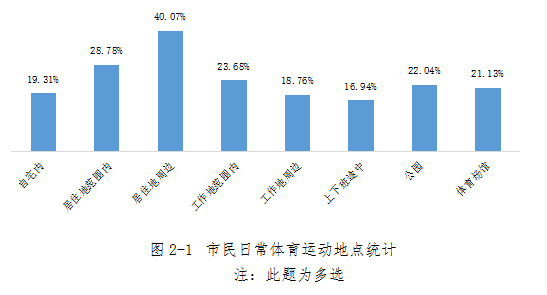
2.1.2 Diversified demand
The survey results show that nearly half of the citizens think that the daily use of sports facilities can not meet the needs of exercise. Further investigation shows that the lack of sports facilities, old facilities or serious damage are the main reasons that affect the use of current facilities. Therefore, the effective supply of various types of sports facilities can fully meet the daily exercise needs of citizens.
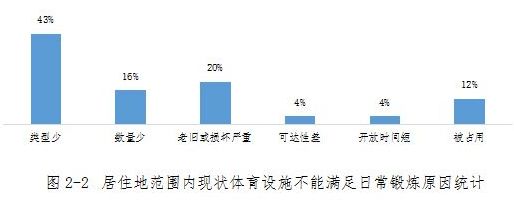
2.1.3 Differentiated demand
The current sports facilities in residential land are mainly outdoor fitness equipment and fitness trails, which meet the needs of daily exercise to a certain extent, but there is still a certain gap with the diversified needs of citizens. The results of the survey conducted for different age groups show that the types of facilities most needed by citizens are inconsistent with the current facilities. For the sports facilities in residential land, young people prefer to add big stadiums and indoor gyms, while middle-aged and elderly people prefer to add small stadiums; For the sports facilities around the residential land, young people and middle-aged and elderly groups hope to add small stadiums and swimming venues. Therefore, the residential land and the sports facilities in the surrounding 15-minute living circle need to take into account the diverse needs of young people and middle-aged and elderly groups, and the newly added facilities are mainly small stadiums, swimming venues and big ball venues.
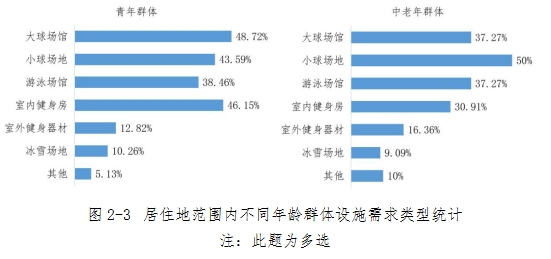
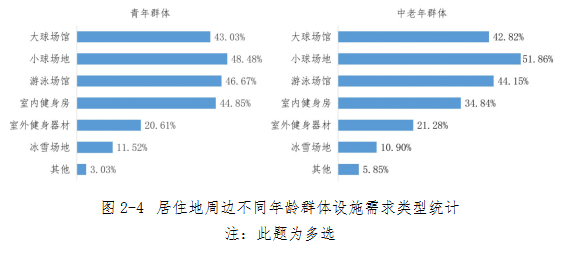
2.2 Demand for international communication-oriented events
Sports and global urban development have strong coupling. Compared with world-famous global cities, sports events have become an important means to expand international influence and build an international city. In recent years, the state has issued a series of policy documents aimed at building a number of influential sports events and sports competition performance industry clusters. Giving full play to the unique advantages of "Double Olympic City" and building a gathering place for international sports events is an important part of realizing the strategic positioning of Beijing as a "four-center" city. Actively introducing and cultivating international events will further help the construction of Beijing’s international exchange center.
2.2.1 Brand Games Demand
At present, a number of well-known international brand events, such as China Open and Beijing Marathon, have taken shape in Beijing international sports events, supplemented by international individual events, national events, municipal events and district-level events. However, compared with the world-famous global cities, Beijing’s international and high-level sports events are not rich enough. In the future, we should actively bid for, introduce and cultivate different types of international sports events, including "three big balls", table tennis, badminton and other popular sports, as well as new and popular sports such as mountain outdoor, ice and snow sports and e-sports. Market-oriented, supplemented by government support, increase support for the main body of the competition, and establish a scientific and standardized long-term organizational mechanism for the competition. We will expand the influence of the games through continuous hosting, and promote the development of local professional games and mass sports participation, and build a series of urban games system.
2.2.2 Sports communication needs
As an important way of cross-cultural communication, foreign sports exchange plays an important media role in connecting Beijing with the world. Beijing takes sports competitions as a platform to actively expand sports exchange activities between governments and people. In the future, Beijing should continue the achievements of foreign sports exchanges and play the leading and exemplary role of the capital under the new pattern of foreign sports exchanges. Insist on "bringing in", but also "going out", and add traditional Chinese sports such as martial arts and dragon boat on the basis of existing exchange projects such as "three balls", table tennis and badminton. Further improve the foreign sports exchange system and carry out sports exchange activities at different levels, scales and forms at home and abroad.
2.2.3 Demand for facilities for the Games
In recent years, Beijing has actively promoted the construction of a number of winter Olympic venues, such as the National Speed Skating Hall and Shougang Ski Jumping Platform. At present, it has world-class venues and supporting facilities, but there are still problems such as low utilization rate after the games and insufficient integration of multi-formats, especially fewer venues that meet the capacity of hosting international sports events. In the future, Beijing should strengthen the scientific planning and layout of newly-built stadiums and facilities, promote the integrated mode of design, construction, operation and management of stadiums and gymnasiums, and organically combine sports economy with the functional needs and post-match utilization of sports events. Encourage the exploration of new market-oriented operation modes, improve the operation and management capabilities of event facilities, and promote the sustainable development of venue facilities.
2.2.4 Cultural needs of the Games
Sports culture is the fundamental driving force for the sustainable development of sports undertakings, and sports culture is the foundation for the establishment of a famous sports city. As an important content of sports culture, sports event culture is an important embodiment of sports soft power. Beijing has profound cultural connotation of sports events, and large-scale sports events have left many cultural contents for the city, such as material, industry, system and spirit. In the future, Beijing should base itself on the advantages of the capital’s cultural heritage, plan widely influential mass sports events, and encourage the development of folk sports activities that people like. Around the hosting process of the games, we will carry out a series of cultural activities before, during and after the games, and set up exhibition spaces for cultural elements of the games, so as to promote the mutual integration and promotion of culture and sports and expand the influence of the games.
2.3 Emerging demand for sports consumption
Driven by a series of policies on developing sports industry and promoting sports consumption, the sports industry has entered a rapid development channel, and a sports market system oriented to the public and focusing on service consumption has taken shape. Affected by the national fitness craze, sports diversification and sports entertainment, sports consumption has been further upgraded, the "sports+"industry has been rapidly integrated, and the sports service industry has developed rapidly. Therefore, adapting to and grasping the emerging demand of sports consumption and improving the sports economic index have become the important contents of accelerating the development of sports industry and promoting the transformation and upgrading of sports industry.
2.3.1 Emerging sports consumption demand
One of the manifestations of the upgrading of sports consumption is the change from traditional national hobbies to various emerging sports. While the traditional table tennis and badminton events continue to maintain a huge audience, there have been high-end niche sports such as skiing, fencing, equestrian, sailing, rowing, diving and aviation. With the upsurge of the 2022 Winter Olympics, the ice and snow project has become a popular sport among the minority. In recent years, nearly 100 youth ice hockey teams and clubs have appeared in Beijing. In the future, Beijing needs to further enrich the consumption types of sports events, strengthen the construction of characteristic fitness and leisure facilities, and focus on building a number of fitness and leisure facilities such as mountain outdoor camps, hiking and cycling service stations, self-driving RV camps, sports boat docks and aviation flight camps. Extend the consumer service chain of minority sports, and promote the development of fitness clothing products, fitness venue equipment, fitness culture media, fitness education and training.
2.3.2 Demand for in-depth experience of sports and leisure
Sports consumption has changed from simple participation to deep experience, especially in the field of sports tourism. Sports tourism is a new industrial form of the integration of tourism industry and sports industry. It takes sports as the core, takes on-the-spot watching, participating in experience and visiting as the main forms, and provides related products and services to the public for the purpose of satisfying health, entertainment, tourism and leisure, involving fitness and leisure, competition performance, equipment manufacturing, facility construction and other formats. The overall plan proposes to unite Zhangjiakou City to build a Beijing-Zhangjia sports and cultural tourism belt. In the future, Beijing should build "sports+tourism" related products, build a number of sports tourism destinations and create a number of sports tourism boutique routes.
2.3.3 Sports space function compound demand
The developed competitive performance industry fully integrates competitive sports with entertainment and leisure by virtue of the ornamental, dramatic and suspense of competitive games. "Super Bowl" has become a golden signboard of American professional sports by virtue of the charm of football itself and the operation of "all-entertainment mode". The entertainment of sports events and the performance of competitions require more complex sports space functions. Madison Square Garden in new york not only holds many professional competitions such as ice hockey and basketball, but also undertakes a large number of art performances, concerts and concerts. In the future, Beijing needs to learn from the Wukesong model, transform the function of a single stadium into an urban sports complex, take sports competition as the core function, expand sports retail, sports experience and other related functions, develop and transform existing stadiums, and realize the integration of functions such as culture, entertainment, catering, performing arts, hotels, conferences and supporting facilities.
Chapter III Planning System
3.1 Planning objectives and principles
3.1.1 Planning objectives
In order to thoroughly implement the national strategy of national fitness for all, fully promote the construction of a sports power, meet the people’s growing needs of multi-level and diversified sports life, and promote the healthy development of sports undertakings, this plan is based on Beijing’s reality, highlights the characteristics of the capital of a big country, closely focuses on the strategic positioning of the "four centers" city, focuses on strengthening people’s physique, improves the "seven haves" and "five natures" sports indicators, and strives to build. Strive to enhance international influence, build the capital into an international sports city, and strive to write a new chapter in the sports cause of "building a world-class harmonious and livable capital".
In building a healthy Beijing and a national model city of national fitness, we should persist in taking people’s health as the center and build a network of national fitness facilities based on the "15-minute fitness circle" around the masses. Improve the public service system of national fitness and realize the equalization and convenience of public sports services; Develop sports popular with the masses and improve the construction of venues and facilities such as "three big balls" and ice and snow sports; Meet the needs of sports activities of different groups of people and strengthen the construction of national fitness facilities serving key groups; Revitalize the existing resources and promote the co-construction and sharing of public facilities; Combine with urban renewal and build national fitness facilities.
In order to enhance the international influence and build the capital into an international sports city, it is necessary to strengthen the construction of science and technology venues, further improve the operation mechanism of large-scale event venues, and build a sports facility system that meets the function of sports communication. Taking the Winter Olympics, Basketball World Cup, Track and Field World Championships, Curling Championships and other international large-scale events, Beijing Marathon and other special events and various leagues as the starting point, we will optimize the functional layout of venues, build a large-scale brand event area with wide international influence, and create a world-class hardware environment. Improve the level of training facilities for competitive sports training, especially for young reserve talents, and build a high-level and high-quality competitive sports training base. Comply with the new trend of sports development and cultivate internationally renowned sports enterprises and brands. Build a platform for gathering, exchange and cooperation of international mass sports organizations, develop a sports economy that matches the strategic positioning of the capital city, and support the construction of an international sports city in the capital.
3.1.2 Planning principles
1. People-oriented, healthy life
Proceeding from the actual needs of the people, we will implement the national strategy of "Healthy China" and "Sports Power", make great efforts to build more sports facilities that the people like, and advocate that urban public sports resources tilt towards projects with high popularity, good mass base and low technical threshold. Advocate physical exercise lifestyle, shape a vibrant and healthy Beijing, and build Beijing into a model city for national fitness.
2. Straighten out the mechanism and expand supply
Adhere to the problem orientation, adhere to the integrated development, innovate the system and mechanism, break down the industry barriers, highlight the key points, step by step, explore the affiliated sports facilities such as schools, institutions, commercial and cultural places, parks and so on to serve the national fitness, and focus on solving the problems of insufficient imbalance of sports facilities, low utilization rate of some sports facilities, idle waste after the game, and insufficient integration of multiple formats.
3. Facilities are compatible and effectively guaranteed.
Advocate the compatibility of sports facilities with all kinds of urban parks, country parks, scenic tourist areas and other facilities, encourage the supplement of non-independent and diverse sports facilities, and strive to achieve a per capita sports venue area of 2.8 square meters at the end of the planning period.
4. Integration of multiple regulations and orderly implementation
Adhere to overall planning and multi-planning, closely connect with zoning planning and detailed planning, form a scientific and efficient planning implementation control system, and ensure the planning landing. Formulate an action plan in an orderly manner and effectively promote the implementation of the plan.
3.2 Functional system
In order to build a national national fitness model city and a capital international sports city, the "4+2" functional system is planned, which includes a national fitness facility system, a competitive training facility system, a youth sports service facility system and a sports event facility system, as well as a sports industry demonstration zone system and a sports cultural exchange platform functional system.
3.2.1 National Fitness Facilities System
Establish a perfect national fitness sports facilities system, and clarify the requirements, standards and measures for the allocation of sports facilities in the "15-minute fitness circle".
3.2.2 Competitive training facilities system
Build competitive training facilities to meet the needs of professional training with high standards, explore the innovative use of existing professional training venues, expand the openness as much as possible, and meet the daily fitness needs of the masses on the basis of ensuring daily training.
3.2.3 Youth sports service facilities system
We will comprehensively guarantee the facilities for sports activities for young people in and out of class, focus on completing the "three big balls" and ice and snow sports training facilities for young people, and build a high-level training base for young reserve talents.
3.2.4 Sports facilities system
Improve the high-standard international and domestic sports facilities system, aiming at improving the popularization rate of various leagues and events, improve the construction of event venues system, and put forward the requirements of joint construction and sharing.
3.2.5 Sports Industry Demonstration Zone System
Optimize the allocation of factors and service supply, promote the transformation of health industry, expand the total scale of sports industry, focus on the development and manufacturing of high-end sports equipment, and promote the upgrading of sports consumption.
3.2.6 Functional system of sports cultural communication platform
Improve the comprehensive utilization level of large-scale sports venues and strengthen openness and sharing. Build urban sports parks and sports corridors, promote sports exchanges between Beijing, Tianjin and Hebei, and build a gathering place for international and domestic sports organizations.
3.3 Hierarchy
This plan optimizes and perfects the four-level configuration system of "national level, municipal level, district level, street/township level" proposed in the previous version of the plan, strengthens the function of national fitness facilities, and merges the national and municipal levels as city level, district level as regional level, street/township level as block level, and adds community-level sports facilities. Encourage the development of urban characteristic projects, increase other sports facilities, and finally establish a "city-level, regional-level, block-level, community-level" four-level national fitness service system plus other sports facilities.
3.3.1 City public sports facilities
Public sports facilities that serve the whole city and a larger area, take competitive events and training as the main functions, take into account the functions of national fitness, youth sports service, sports industry demonstration, sports and cultural exchanges, and mainly undertake high-level international and domestic comprehensive events or individual events, and must occupy an independent area. City-level public sports facilities should make full use of the current situation or the original planned land, close to rail transit or urban expressway layout.
3.3.2 Regional public sports facilities
Public sports facilities that serve densely populated areas in various districts, take national fitness as the main function, take into account the functions of competitive events, competitive training and youth sports services, take into account the functions of sports industry demonstration and sports cultural exchanges, and mainly undertake the daily training of mass sports events and district-level professional sports teams, and must occupy an independent area. Regional public sports facilities should make full use of the current situation or the original planned land, and be close to the layout of rail transit or urban main roads.
3.3.3 Block-level public sports facilities
Public sports facilities that serve the streets, towns and villages, take national fitness as the main function, give consideration to the youth sports service function, and mainly meet the needs of mass sports with high professionalism and large venue demand, and can occupy an area independently or be jointly built with other public facilities. Block-level public sports facilities are close to the primary and secondary trunk roads of the city, and are integrated with other public facilities and parks and green spaces.
3.3.4 community-level public sports facilities
Public sports facilities serving the residents of communities and administrative villages, with daily fitness activities as the main function, can occupy an area independently or be arranged in a compatible way with public facilities, parks, green spaces and residential land. Community-level public sports facilities should encourage the use of stock space, combined with the overall layout of existing facilities.
3.3.5 Other sports facilities
Fully combine resource endowments to build characteristic sports events, such as water sports, marathon, cycling around the city, outdoor sports, etc., which do not occupy land independently and are integrated with urban resources. Advocate and encourage affiliated sports facilities such as schools, government agencies, enterprises and institutions, commercial and cultural places, parks, etc. to refer to the corresponding block-level and community-level public sports facilities level configuration content and standard construction according to the scale of land occupation.
3.4 Hierarchical Configuration Content
3.4.1 City public sports facilities
City-level public sports facilities take "two groups" as the main configuration content, and strengthen the competition venues and training venues.
Six major competition venues and venues: Combining with the current large-scale public sports facilities, we will build competition venues and venues in the Olympic Sports Center, Workers’ Stadium, Wukesong, Shougang, the Green Center of the City Sub-center and Yanqing Winter Olympics.
Four major competition venues: longtan lake, Baishiqiao and Laoshan comprehensive competition venues, and a new "Three Big Balls" youth training base will be built in the southern part of the city or other areas.
3.4.2 Regional public sports facilities
Regional public sports facilities include sports centers, large national fitness centers and large sports parks. The total land area can be allocated according to 3-20 hectares.
Sports Center: A comprehensive sports center that undertakes regional sports events and cultural activities should occupy an independent area of 3-10 hectares, with at least one in each district, including stadiums, gymnasiums, swimming pools, tennis courts, skating rinks and comprehensive gymnasiums.
Large-scale national fitness center: it provides a variety of national fitness services in a centralized way, and should independently occupy an area of more than 3 hectares, serving 300,000-500,000 people, including various indoor and outdoor sports venues, and there should be no less than 12 mass sports events. It is encouraged to set up special sports events and traditional sports venues.
Large-scale sports parks: Parks with outdoor sports venues should occupy an area of 8-20 hectares independently. They can be located in densely populated areas, and the green space rate should not be higher than 30%.
3.4.3 Block-level public sports facilities
Block-level public sports facilities mainly serve the 3 km fitness circle, including medium-sized national fitness center and medium-sized sports park.
Medium-sized National Fitness Center: It mainly provides national fitness services with a large area and strong professionalism. It should occupy an independent area of 1-3 hectares and serve 100,000-150,000 people, including various indoor and outdoor sports venues. There should be no less than 6 mass sports events, and the establishment of youth sports venues is encouraged.
Medium-sized sports park: The park, which is dominated by outdoor sports venues, should independently occupy an area of 3-8 hectares, and can be located around large residential areas, and the green space rate should not be higher than 20%.
3.4.4 Community public sports facilities
Community-level public sports facilities mainly serve the 1 km fitness circle, including small national fitness centers and small sports parks.
Small National Fitness Center: It mainly provides national fitness services with a small area and high popularity. It should occupy an independent area of 0.1-1 hectare and serve 30,000-50,000 people. It is encouraged to set up multi-functional venues, fitness squares for the elderly, children’s activity venues, etc.
Small-scale sports parks: Parks that are mainly outdoor sports venues should occupy an area of 1-3 hectares independently, and can be located around residential areas, and the green space rate should not be higher than 20%.
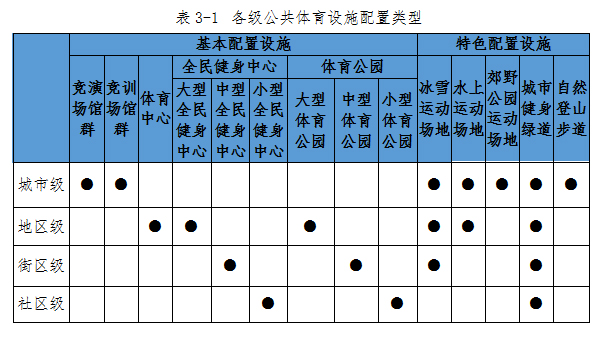
3.4.5 Construction standards of public sports facilities at all levels
The construction of public sports facilities at all levels shall be implemented with reference to the current construction standards such as Code for Design of Sports Buildings (JGJ31-2003), Land Use Control Index of Urban Public Sports Venues (Guo Tu Zi Gui [2017] No.11) and Configuration Requirements of Multifunctional Public Sports Fields in Urban Communities (GB/T 34419-2017).
3.5 hierarchical land use standards
3.5.1 Public sports facilities at city level and regional level.
In order to enhance the international influence and build the capital into an international sports city, the planned per capita area of public sports land for city-level and regional-level facilities is 0.35-0.48 square meters. The index should be unified accounting within the city.
City-level public sports facilities: the main task is to provide high-level venues for international and domestic comprehensive events or individual events, and focus on ensuring large-scale venues and facilities in the Winter Olympics and city sub-centers to meet the youth training needs of competitive sports such as "Three Big Balls".
District-level public sports facilities: the main task is to provide large-scale comprehensive sports events, mass sports events, national fitness, daily training of district-level professional sports teams and special project venues, and focus on improving sports centers in various districts, large-scale national fitness centers and large-scale sports parks newly built or rebuilt in various districts.
3.5.2 Block-level and community-level public sports facilities
In order to build a healthy Beijing and a national fitness model city, the planned per capita public sports land area index of block-level and community-level facilities is 0.35-0.42 square meters. This indicator should be calculated according to the resident population of the block and community.
Block-level public sports facilities: mainly serve the 3 km fitness circle (15 minutes by bike), provide venues for residents’ daily fitness activities and professional sports training, and build or rebuild medium-sized national fitness centers and medium-sized sports parks.
Community-level public sports facilities: mainly serving the 1 km fitness circle (15 minutes’ walk), with the main task of providing venues for residents’ daily fitness activities, and constructing small national fitness centers and small sports parks.
Chapter IV Spatial Layout
4.1 Layout principle
4.1.1 Balanced allocation of the whole city
The layout of sports facilities in Beijing should be based on the basic principle of "balanced allocation of sports venues resources in the whole city", shift the focus of sports venues construction to Nancheng, and gradually increase the supply of sports venues in Nancheng to meet the venue needs of Nancheng residents. At the level of each district, there is a big gap in the types of sports venues. On the one hand, we should pay close attention to the construction of basic sports facilities to narrow the relevant gap. On the other hand, we should introduce and apply modern enterprise system through tax incentives, financial subsidies, purchase services, etc., and encourage social capital to invest in the construction, operation and management of sports facilities, so that people can enjoy sports venues resources fairly.
4.1.2 Flat layout of facilities
This plan understands the people’s daily fitness needs through various forms such as current situation investigation and questionnaire distribution. The layout of facilities should be guided by the needs of the masses, instead of serving food by the government in the past, citizens should order food, face the masses and face the future, and focus on supplementing the sports facilities in the 15-minute life circle around the masses, taking into account the needs of different groups of teenagers and the elderly on the principle of flexibility and application, and promoting the flattening of the layout of sports facilities.
4.1.3 Compatible composite utilization
Urban built-up areas are short of land resources, and sports facilities should be combined with the construction of schools, government agencies, enterprises and institutions, commercial and cultural places, parks, etc., to increase land compatibility, save intensive land, and solve the problem of insufficient supply of land for sports venues. In addition, it is also necessary to strengthen the functional combination of buildings, including transforming abandoned industrial factories into sports spaces, encouraging buildings such as shopping malls and office buildings to open gyms, exercise rooms, indoor courts and other sports venues on roof platforms or indoors, and giving corresponding preferential policies.
4.2 Spatial Circle Planning Strategy
4.2.1 Capital Functional Core Area
Excavate the stock: combine the vacated space resources and supplement the supply of public sports facilities on the basis of the functional construction of "four centers".
See the needle: In combination with the renovation of old residential areas and bungalows, community-level public sports facilities will be added to improve the current situation of insufficient sports facilities in the old city.
Co-construction and sharing: Combine schools, government agencies, enterprises and institutions, commercial and cultural sites, parks and other sports facilities to improve the comprehensive service level.
4.2.2 Central City
Stock utilization: increase the supply of public sports facilities and promote the upgrading of large-scale sports facilities by combining the space resources of demolition and evacuation.
Zoning strategy: Chaoyang District will strengthen the utilization of large-scale venues after the game, evenly distribute points at the block level, and strengthen the function of national fitness. Haidian district strengthens the implementation of planning public sports land in mountainous areas and encourages the opening of sports facilities in colleges and universities; Fengtai District strengthens the construction of public sports facilities in Fengtai Science Park area and densely populated areas; Shijingshan District will strengthen the construction of national fitness and sports facilities in combination with the existing land.
4.2.3 City Sub-center
Complementarity with the central city: the functions of large and medium-sized sports facilities complement each other with the central city, promoting the comprehensive and diversified development of sports facilities.
Characteristic guidance: On the basis of complementing the sports facilities in the central city, we will focus on sports such as football, ice and snow, table tennis and badminton, water sports and teenagers, carry out the planning and construction of characteristic sports facilities, and build a demonstration area of sports facilities.
4.2.4 Multi-point area
Improve the hierarchical configuration: on the basis of the existing sports facilities in each district, improve the system of public sports facilities at the regional, block and community levels.
Highlight quality characteristics: Combine the construction of key functional areas such as Future Science City, Beijing Economic and Technological Development Zone, Shahe Higher Education Park and Liangxiang University City, as well as the construction of new towns and characteristic towns, and build a number of high-quality sports facilities.
4.2.5 Ecological Conservation Area
Strengthen the sports function of the new city: improve the public service system of national fitness at the regional, block and community levels throughout the country, and give priority to the planning and construction of public sports facilities in the new city.
Give full play to resource endowment: give full play to the characteristics of landscape resources in ecological conservation areas, promote the coordinated development of sports activities in Beijing, Tianjin and Hebei, create characteristic sports, and build ecological and gridded sports venues.
4.3 the city’s sports land planning scheme
In order to ensure the effective landing of the planned public sports land, this plan is deeply connected with the Regulatory Detailed Planning of the Capital Functional Core Area (block level) (2018-2035) and the Regulatory Detailed Planning of the City Sub-center (block level) (2016-2035) and the zoning plans, and a total of 625 public sports land are planned and laid out, with a total area of about 1,668 hectares.
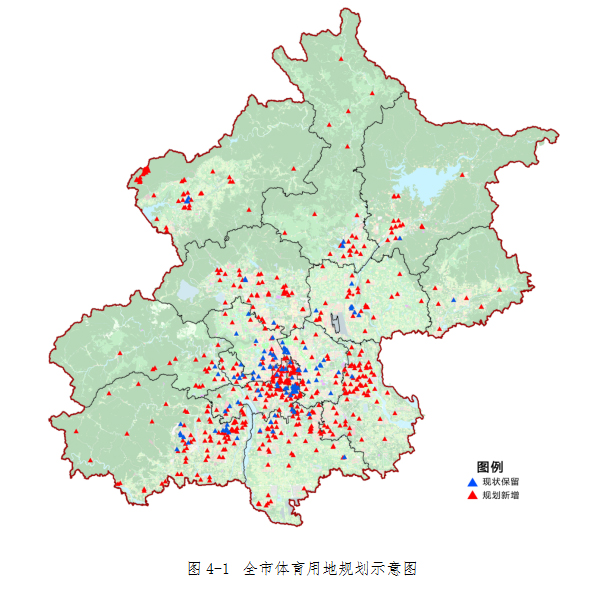
4.4 Different types of sports facilities layout strategy
4.4.1 "Three Balls" Facilities
1 new areas in accordance with the standard construction of "three balls" facilities.
Newly-built areas and schools should build "three big balls" venues and facilities in accordance with relevant standards, which can be configured in the form of multi-functional public sports fields compatible with football, basketball and volleyball. Conditional areas and schools can configure venues according to projects. The newly-built residential area should be combined with the 15-minute living circle to strengthen the construction of the "three big balls" site in the community, and the facilities of the "three big balls" site should be designed, constructed and used simultaneously with the residential area.
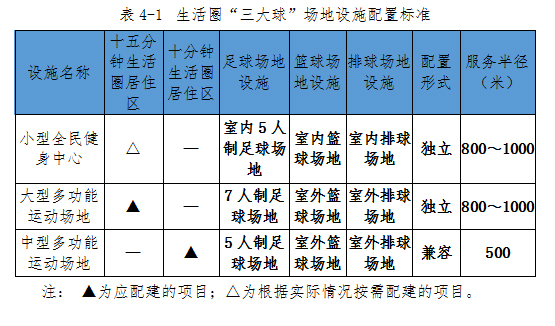
2. When the site conditions can’t meet the size of the regular site due to the current situation, you can choose to build an irregular site.
When conditions permit, regular venues should be given priority. When the community land is extremely tight, we can flexibly use the existing resources and build non-standard "three-ball" venues according to local conditions on the premise of ensuring safety, such as irregular football fields, irregular basketball courts, cage football, cage basketball field and volleyball walls.

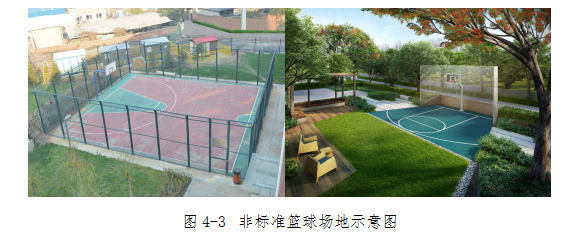

3. In combination with the renovation of old residential areas, reduction and upgrading, etc., encourage the construction of "three big balls" venues and facilities with land for evacuation.
Rational use of parks, abandoned industrial and mining land, floodplain land, wasteland, idle land and so on to build "three big balls" facilities. Large-scale sports parks and country parks can build standard venues, and other land can build standard or non-standard venues according to specific conditions.
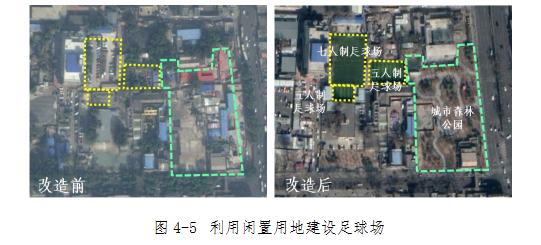
4.4.2 Ice and snow sports ground
1. Tap the potential stock resources to build ice sports venues and facilities.
Encourage schools to build skating halls; Promote outdoor natural ice rinks and encourage the construction of detachable ice rinks in parks, campuses, squares and communities; Support qualified areas and schools to build ice rinks in winter; Encourage the transformation of old factories and buildings into skating rinks.
2. Expand the capacity-increasing ski resorts and supporting facilities, and encourage the construction of temporary ski resorts in winter.
Encourage the expansion and upgrading of some existing ski resorts, improve supporting service facilities and enrich the types of winter activities under the conditions of conforming to the land policy; Relying on major parks, squares, stadiums, leisure and cultural tourism sites, etc., temporary snow fields will be built in winter.
4.4.3 Community sports facilities
1. Use idle land in the corners to build community sports facilities.
Excavate the idle land resources in the corner of the old city, and build after confirming the ownership and the nature of the planned land; Building community sports facilities in old communities; New residential areas should be in accordance with the requirements of relevant indicators, the construction of supporting sports facilities.
2. Combine community culture and greening facilities to build different types of "community sports cultural facilities".
Comprehensive type: the land use conditions are relatively square and flat, and the area is relatively large. It is appropriate to build sports venues such as "Three Big Balls" and support some cultural and recreational facilities.
Garden type: The land is irregular or has a large slope. After renovation, it is advisable to give priority to landscaping, and build a small number of badminton courts, basketball courts, table tennis courts and other sports venues to support children’s activities and cultural and recreational facilities.
Hydrophilic: The riparian land with gentle and narrow land should be mainly ecological landscape, and facilities such as fitness trails, badminton and table tennis courts can be built to support cultural and recreational facilities.
3. Create a vibrant community public service center.
Create a new generation of community public service centers that provide all kinds of public management and public services, fully integrate sports facilities of a certain scale, and inject vitality into the community. In addition to sports facilities such as sports ground and swimming pool, the center can also include public service center, family health center, library, sports science and technology center, elderly activity center, clubs, small sales outlets and retail stores to provide comprehensive public services for residents.
Sports facilities are integrated with community public service centers, parks and green spaces, and the community is connected with city slow traffic system, forming a more dynamic urban street view. Community-equipped open-air stadiums can hold community sports events or introduce social events to undertake collective activities of residents and improve space utilization.
4.4.4 Park compatible sports facilities
Park and sports facilities should be combined to build a public space with physical exercise as the main function, park culture and leisure function, greening as the foundation, certain environmental quality and open to residents. According to people’s leisure and fitness needs, sports facilities can be added in the conditional area of the current park. It is suggested that the new park should refer to the compatible ratio in the table below to build corresponding sports facilities.
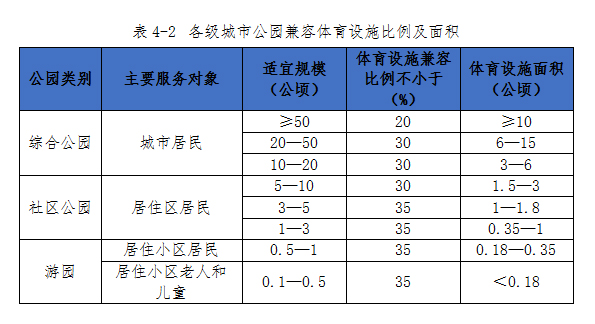
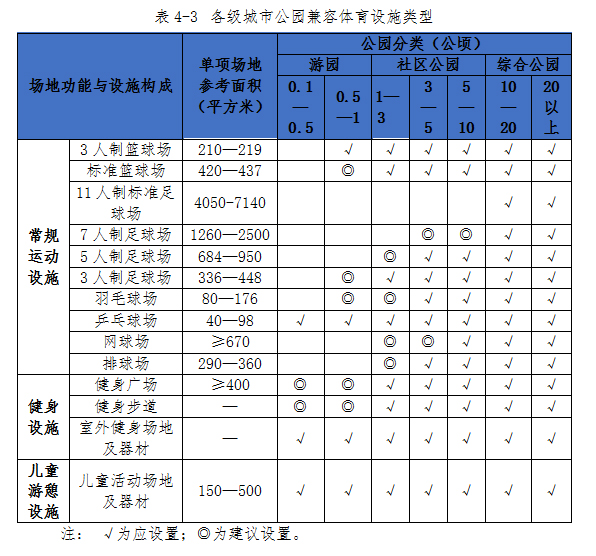
4.4.5 Fitness trails
1. Create a city "jogging route" and build a city jogging service facility system.
Combined with natural parks, cultural attractions, relying on water system greenways and living roads, a number of fitness trails will be built to improve the environmental quality of streets along the line.
Encourage the construction of intelligent trails in combination with key functional areas to provide convenient fitness facilities for the working population.
Set up "running station" and "running service center" in combination with subway stations and community service centers, provide running-related services such as rental, shower and storage, and set up vending machines and other convenient facilities along the running route.
2. Build hiking trails and build leisure sports destinations in rural cities.
Relying on the mountain landform and ecological environment, we will build a "trinity" mountaineering fitness trail system including mountaineering fitness trail, mountain bike trail and tourist landscape trail. Connect country tourism resources in series, and build mountaineering fitness routes with different themes and different durations according to the needs of different groups of people.
4.4.6 marathon route selection
Combined with the Grand Canal, Wenyu River, Chaobai River, Yongding River and other rivers, as well as ecological spaces such as country parks and city parks, various types of marathon routes are carefully designed by using the series connection of urban greenways to create city-level or regional-level well-known brand events.
4.4.7 Reconstruction and utilization of old buildings
It is necessary to build sports facilities according to local conditions, encourage all subjects to use the existing building space such as industrial factories and commercial buildings to update and transform sports facilities, and allow them to adjust the use function, lease term, parking space ratio and fire fighting and other related construction requirements according to the design requirements of sports facilities. Rational use of parks and other facilities to build football fields, basketball courts, volleyball courts and other sports facilities, encourage social capital to participate in investment and construction and enjoy the corresponding rights and interests according to the law.
4.5 Promote the development of urban sports industry
4.5.1 Diversified services
Implant cultural and commercial elements around sports facilities, provide diversified services, and create a new hot spot for sports and leisure consumption in cities. By enriching the format, we will create an interactive experience life circle so that citizens can fully experience the all-round interactive life of culture, sports, art, science and technology and entertainment. Take the catering and entertainment industries as the leading factors to create a gathering place for the city’s late-night vitality and an experience place for the late-night lifestyle. Diversified project development is carried out for different types of buildings and sites, and the supply side provides rich product types to meet the needs of different customers and consumers.
4.5.2 Optimize industrial land supply
Each district should consider the layout of sports land as a whole when compiling the national land space plan, and increase the support for the new construction land of sports industry when arranging the annual land use plan. The use of the stock of real estate and land acquired by means of allocation to set up sports industry can be handled according to the allocation method if it conforms to the Catalogue of Allocated Land, and can be handled by agreement transfer if it does not conform to the Catalogue of Allocated Land. Encourage all localities to explore the use of collective construction land and qualified "four barren" (barren hills, ditches, hills and beaches) land to develop sports industry.
4.5.3 "Sports+"Action
Implement the "Sports Plus" action to promote the integrated development of sports industry, medical care, tourism, education and commerce.
1. Promote the integration of sports and medicine.
Incorporate the core indicators of sports industry development into the national health city selection system. Encourage hospitals to train and introduce sports rehabilitation teachers, carry out sports to promote health guidance, and promote the formation of a disease management and health service model integrating sports and medicine. Improve the national physical fitness monitoring index system, and incorporate relevant indicators into the recommended range of residents’ health checkups. Provide targeted sports fitness programs or sports guidance services for different groups of people, promote scientific fitness and improve fitness effects. Strengthen non-medical health intervention for the elderly, popularize fitness knowledge and organize fitness activities.
2. Encourage the integrated development of sports and tourism.
Explore the inclusion of sports tourism in national and industry standards such as tourist resorts. Implement the demonstration project of sports tourism boutique, and build a number of influential sports tourism boutique routes, boutique events and demonstration bases. Standardize and guide the construction of sports tourism demonstration areas. Take mountaineering, hiking, cross-country running and other sports as the important direction of developing forest tourism.
3. Accelerate the integration of sports and education.
Through the government’s purchase of services, professional coaches, retired athletes and sports training institutions are introduced to provide guidance for extracurricular sports training and competitions in schools. Encourage the inclusion of sports bases and sports camps in youth research bases. Improve the system of school physical education teaching, training and competition, and support schools and sports departments to establish a common training mechanism for athletes. Taking swimming, track and field as the pilot, the qualified events sponsored by the education department will be included in the athletes’ technical grade evaluation system. Strengthen the construction of high-level sports teams in colleges and universities and bring them into the national competitive sports reserve talent training system.
4.5.4 Helping the night economy
1. Create a landmark, business circle and life circle of "Night Capital"
Create four landmarks of Qianmen Dashilan, Sanlitun, Guomao and Wukesong, and nine business and living circles of Blue Harbor, World Trade day order, Guijie, Heshenghui, Langyuan, Shibao Street, Huiju, COFCO Xiangyun Town and Olympic Park.
2. Vigorously promote the expansion of mass sports events at night.
On the basis of the landmark, business circle and life circle of the night capital, we will further expand the scope of mass sports events at night, create a series of mass sports events of "Lighting the Night Capital", hold mass sports events such as marathon fluorescent fun run, and continuously enrich the items and contents of mass sports events at night.
3. Promote night sports consumption
Actively implement the "Measures of Beijing on Further Prospering Night Economy and Promoting Consumption Growth". First, hold brand events such as the 2023 AFC Asian Cup Football Tournament and China Tennis Open to better meet the needs of citizens to watch high-level events. Second, according to the newly revised "Administrative Measures for Evaluation and Reward of Professional Sports Clubs in Beijing", the professional sports clubs in this city will be evaluated and rewarded, so as to improve the attendance rate of events and promote citizens’ night sports consumption. Third, continue to support sports business units to extend business hours and continuously meet the needs of multi-level citizens for physical fitness.
4.5.5 Market-oriented means
Sports facilities should adhere to the principle of public welfare, serve the public, promote the open use of national fitness facilities, and be close to the people, convenient and beneficial to the people.
The investment mode of sports facilities should not only rely on government investment, but also introduce and apply modern enterprise system through tax incentives, financial subsidies and purchase of services, encourage social capital to invest in the construction and operation of management facilities, and mobilize enterprises and individuals to invest in the construction of sports facilities. It is necessary to correctly handle the relationship between the government and the market, persist in reform and innovation, use market-oriented means while the government invests in the construction of basic public sports facilities, and promote the efficient allocation of resources in the sports market through the separation of ownership and management rights, and timely introduce new auxiliary policies and measures to put PPP, BOT and private investment in construction and operation in a more prominent position.
Chapter V Implementation Guarantee
5.1 Implementation strategy
5.1.1 Overall planning, multi-planning, strengthening scientific and efficient planning control system.
Strengthen regional overall planning and realize unified planning, unified policies and unified management and control. Under the guidance of this special plan, sports facilities will be implemented in the detailed planning and comprehensive implementation plan, and will be included in the management and control platform of urban public facilities, and it is forbidden to use them for other purposes at will.
5.1.2 Market-oriented, innovation-driven, to achieve perfect matching of urban functions and quality improvement.
Encourage the government to simplify administration and decentralize power, innovate investment and financing models, and give enterprises greater freedom and profit space. Study and introduce relevant policies to encourage social investment to participate in the construction of sports facilities. It is allowed to allocate a certain proportion (it is recommended not to exceed 10%) of operating supporting facilities, to transfer the naming rights of venues, to develop derivatives of events, to change the single profit model, and to intensify the implementation of planning public sports land.
5.1.3 Reform and innovation, integrate development, and set a benchmark for urban construction.
Adhere to reform and innovation, carry out relevant policy research on bringing schools, government agencies, enterprises and institutions, commercial and cultural sites and affiliated sports facilities in parks into the statistical caliber of sports land, and introduce measures to promote the opening of facilities to improve the utilization rate of sports venues. Focus on strengthening the construction of sports facilities around the masses, break the limitations of departments, promote the open and cooperative construction of sports facilities in various industries, promote the composite use of various types of land and space, and encourage the co-construction and sharing of facilities. Coordinate the integration and development of national fitness, competitive sports events, culture, entertainment and leisure.
5.1.4 Excavate the stock, establish a ledger and reserve supplementary resources for sports land.
Combined with the work of "dredging and promoting", the city’s spatial resources are sorted out, and classified statistics are made based on information such as land area, land ownership and spatial location, which are included in the supplementary reserve resources of sports land to reserve space for subsequent implementation.
5.1.5 Focus on breakthroughs, strive for practical results, and create a new situation of healthy cities with major projects and key events as the starting point.
Guided by the "three big balls" and other advantageous projects, we will strengthen the scientific and technological functions of venues, introduce international high-level events, and strengthen the combination of city image and sportsmanship. Incorporate the construction of block-level and community-level sports facilities determined by the plan into the financial budget, and encourage social capital to participate in investment, construction and operation.
5.1.6 Explore the establishment of a security mechanism for public sports facilities.
Establish sports facilities property safety system and insurance system, sign insurance for the behavior in the process of using sports facilities, explore the establishment of special-purpose insurance fund, and solve the problem of accident compensation.
5.2 Policy mechanism
5.2.1 Establish a physical examination mechanism for public sports land.
Combined with the urban physical examination work, establish a physical examination mechanism for public sports land, and carry out regular evaluation on the current use and operation of public sports land and the implementation of planning public sports land.
5.2.2 Further promote the opening of sports facilities affiliated to schools, government agencies, enterprises and institutions.
Through the cooperation of various departments, the responsibility subject and the government’s purchase of services will be clarified, and the degree of opening up of sports facilities affiliated to schools, institutions, enterprises and institutions will be further improved.
5.2.3 Study on the compatibility of non-sports land and temporary land with public sports facilities.
In country parks, city parks, road square spaces, public service facilities and other non-sports land or urban vacant and idle land, public sports facilities will be built. Clarify the allocation standards, construction guidelines, control requirements, management and maintenance responsibilities and sources of funds for the construction of public sports facilities with non-sports land and temporary land.
5.2.4 Study on the function of non-capital to vacate land for the construction of public sports facilities.
Combined with the wishes of the land owner, the original land is allowed to convert the existing industrial, commercial and other land into sports land for continued use in accordance with the way of allocation or agreement transfer. Make use of the land resources to make up the shortcomings of regional sports facilities first, and build the required sports facilities in combination with the wishes of surrounding residents. Encourage the renovation and reuse of industrial workshops, commercial buildings and other building spaces after reconciliation, and give priority to the construction of national fitness facilities.
5.2.5 Study the accounting mechanism of public sports land index.
Most of the planned public sports land is supplied in the form of independent land occupation, and the form is relatively simple. Under the future development trend of mixed and efficient land use, we should encourage the exploration of more efficient and integrated land supply methods for sports land, and encourage the mixed use of land. For sports facilities compatible with various types of land, they can be converted into public sports land indicators according to factors such as their floor space and opening time. For special areas such as historical and cultural blocks, sports facilities and allocation indicators should be arranged according to local conditions.
5.2.6 Relying on social forces to build public sports facilities
Broaden the sources of funds for the construction of public sports facilities and establish a diversified investment mechanism with public finance as a lever and absorbing social capital. Formulate targeted policies and increase investment, and the growth rate of funds for the construction of public sports service system is not lower than that of fiscal revenue; Encourage social capital investment, actively guide non-public capital to enter the field of sports industry, such as venue operation, competition performance, event planning, etc., and issue investment guides to establish goals and directions; The construction of public sports facilities will be included in the overall planning of economic and social development and urban construction, and under the guidance of special government funds, multi-channel financing and resource allocation will be carried out to vigorously promote the implementation of sports facilities; Clarify the government’s financial security responsibility and sharing ratio, and determine the proportion of public sports service expenditure in financial expenditure in the form of special finance.
5.2.7 Innovation of public sports service supply mode
Innovate the supply mode of public sports services, and provide diversified public sports services according to the interests and habits of different groups, such as activating community residents’ sports waiters, localizing villagers’ sports services, campus-based youth sports services, and socialization of sports services for the elderly and the disabled. Vigorously develop the sports service industry, closely focus on the industrial layout, promote the integration of sports industry with pension, tourism, education and other industries, and create special formats such as sports training and sports media. Promote the integrated development of sports facilities, community public service centers and community commercial centers, continuously enrich public sports products and services, and promote sports consumption.
5.3 Management and operation
5.3.1 Reform the management mechanism of sports venues, adhere to integrated development and promote the market-oriented operation of public sports facilities.
Reform the management system of sports venues, realize the coexistence of various management modes, and gradually form a three-legged situation of independent operation, entrusted operation and cooperative operation of sports venues to enhance the social benefits and economic value of sports venues.
For self-operated sports venues, we should encourage diversified business activities, form a diversified sports service system, develop the comprehensive functions of sports venues, develop sports competitions, performances, culture and entertainment, and tap the market value of sports venues.
For non-autonomous sports venues, we should avoid administrative intervention in sports venues, give full play to the main role of enterprises, and rely on the "public-private cooperation" model to entrust the management right of sports venues to professional sports venues operating companies through contract contracting, franchising and other forms, which are responsible for the external operation and market development of sports venues. The government gives the sports venues operating companies the right to operate profits, and the government is only responsible for supervising the operating norms of sports venues.
5.3.2 Cultivate sports associations and intermediary organizations to promote the healthy development of sports industry.
Relying on sports venues, actively cultivate multi-form and multi-level sports clubs, sports associations and intermediary organizations, undertake sports events and daily sports activities at all levels, and promote the healthy development of sports industry.
5.3.3 The government leads and drives to expand investment and financing channels.
Give play to the leading role of government funds, actively expand the investment and financing channels of sports industry, and create a good environment for the construction and operation of social capital investment venues.
5.3.4 Strengthen the development and utilization of large stadiums and take the initiative to undertake major international competitions.
Adopt diversified business model, take theme activities and large-scale projects as profit points, and develop large-scale stadiums into comprehensive venues and facilities integrating sports, entertainment, tourism, commerce and culture; Increase the number of sports events, through the introduction of professional sports competitions, make large stadiums as professional sports arenas and the main venues of professional clubs, and take tickets, broadcasting and training as stable sources of income to ensure the efficiency of large stadiums; Increase the market development of large-scale stadiums and gymnasiums, and expand income channels by selling naming rights to stadiums and gymnasiums or facilities in venues.
5.3.5 Cultivate independent brand projects and integrate into people’s life.
Make use of the characteristics of large-scale venues and facilities, expand sports retail, sports experience and other related functions, strive to establish independent brand competitions, art exhibition brands and cultural performance brands, carry out colorful competitions and performances that the masses like, and build a platform for cultural and artistic exchanges.
5.3.6 Promote the intelligentization of sports facilities.
Promote the intelligent development of national fitness, and promote the construction of intelligent fitness paths, fitness trails and sports parks. Artificial intelligence technology can be used to improve the service level and utilization efficiency of facilities.
Encourage key functional areas and other areas to use open blocks to realize intelligent trails, and provide intelligent punching, safety improvement, sports propaganda, sports guidance, sports services, sports incentives, sports socialization and other service functions.
5.3.7 Actively promote the construction of public sports service information platform.
Establish a comprehensive information platform for public sports services in the city, and provide services such as venue reservation, information inquiry and online registration by using modern technology such as mobile internet; Cooperate with relevant media to promote competitive sports, create a propaganda atmosphere for top-level events, popularize scientific fitness knowledge, and guide the masses to scientific fitness; Give full play to the role of the national physical fitness monitoring system, and carry out mass physical fitness testing and sports ability evaluation.
5.3.8 Actively cultivate sports service professionals.
Strengthen the operation and management of grass-roots cultural and sports facilities, and the sports authorities shall provide professional guidance and supervision to them; Reasonable allocation of full-time and part-time public sports service personnel, block-level posts, community-level sports work coordinators; We can contact local universities and scientific research institutes to implement "political Industry-University-Research" cooperation, conduct special research on the policy introduction and industrial development of public sports services, and strive to cultivate a professional talent team.
5.3.9 Promote the socialization of sports facilities.
Form a more diversified public sports service governance pattern from the aspects of facing the masses, facing the market, simplifying administration and decentralization, and ensure that sports social organizations are better integrated into the social governance process.
